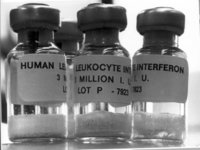PURPOSE: One of the most lethal cancers is non-small cell lung carcinoma (NSCLC), which is resistant to chemotherapy- and irradiation-induced programmed cell death or apoptosis. Our objective is to define processes in NSCLC opposing apoptosis. Previously, we showed IFN[gamma] potently inhibits proliferation of human NSCLC A549 cells under optimal growth conditions by a process involving transcription factor STAT1. Here we investigated whether IFN[gamma] made A549 cells susceptible to activation of the death receptor FAS.
METHODS: A549 cells grown with 10% serum were treated as follows: vehicle, 10 ng/ml IFN[gamma], 70 ng/ml activating FAS antibody, or 10 ng/nd IFN[gamma] and 70 ng/ml FAS antibody. After 48 h, apoptosis was measured by DNA laddering, annexin V binding, and Western immunoblotting for PARP and caspase 3 cleavage. FAS was measured by Westerns, protein by BioRad DC assay. Cells were transfected with siRNA STAT1 using lipofectamine. Statistical significance (P < 0.05) was determined by ANOVA.
RESULTS: IFN[gamma] did not induce apoptosis of A549 cells as indexed by PARP or caspase 3 cleavage, DNA laddering, or annexin V binding. Neither did the agonistic anti-FAS antibody. However, together, they induced marked apoptosis as indexed by all 4 assays and loss of protein from culture dishes. The permissive effect of IFN[gamma] on FAS-induced apoptosis was not due to upregulation of FAS, as A549 cells expressed FAS and its expression was not affected by IFN[gamma]. To assess the role of STAT1, cells were transfected with STAT1 siRNA or lipofectamine alone (control) prior to treatment. Although STAT1 expression was down-regulated with siRNA, PARP and caspase 3 cleavage were still observed with the combination of IFN[gamma] and FAS antibody.
CONCLUSION: IFN[gamma] plays a permissive role in FAS-mediated apoptosis of NSCLC A549 cells by a process downstream of FAS and independent of STAT1. Further studies are underway to determine which STAT1-independent mechanism sensitizes A549 cells to apoptosis.
CLINICAL IMPLICATIONS: The combination of IFN[gamma] and activating FAS antibody could be a novel therapeutic strategy in the treatment of non-small cell lung cancer.
DISCLOSURE: Christopher Spradley, Product/procedure/technique that is considered research and is NOT yet approved for any purpose. The combination of IFN[gamma] and activating FAS antibody in the treatment of non-small cell lung cancer.
J. R. Brewer BA Christopher Spradley MD * Jeremy L. Nickolai BS Richard E. Winn MD George W. Booz PhD Scott & White Hospital and Clinic, Temple, TX
COPYRIGHT 2005 American College of Chest Physicians
COPYRIGHT 2005 Gale Group



